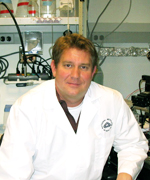Colleagues: Recently Tenured
JAMES M. ANDERSON, M.D., PH.D., NHLBI
Senior Investigator, Cell Biology and Physiology Center

Education: Yale University, New Haven, Conn. (B.S. in biology); Harvard University, Cambridge, Mass. (Ph.D. in biology); Harvard Medical School, Boston (M.D.)
Training: Residency in internal medicine and postdoctoral training in Departments of Biology and Internal Medicine at Yale
Before NIH: Professor and chair of Department of Cell and Molecular Physiology, University of North Carolina, Chapel Hill; professor of internal medicine and cell biology, Yale
Came to NIH: In September 2010
Selected professional activities: NIH Deputy Director for Program Coordination, Planning, and Strategic Initiatives
Outside interests: Cycling; swimming; reading; cooking
Research interests: Since the late 1980s, my research has focused on the cell biology and physiology of epithelial tight junctions, the cell-membrane contacts that seal tissue spaces. Tight junctions prevent material from leaking between epithelial and endothelial cells and have biological, medical, and pharmacological importance. Before coming to NIH, I identified and characterized the function of several of the first known tight-junction proteins. My team and our collaborators identified the PDZ domain—a common interaction domain in tight-junction proteins—and defined its ligand-binding specificity.
Our group also demonstrated that claudins, the key family of tight-junction sealing proteins, create charge- and size-selective pores through the tight junction to allow tissue-specific ion permeability. Our insights helped explain the selective transport properties of junctions in different epithelia and how the barrier is altered in diseases, including several variants caused by genetic mutations. We have expanded our study to a systems biology characterization of the functional networks and pathways—operating at tight junctions—that control cell polarity, signaling, and the cytoskeleton.
JEFFREY C. GILDERSLEEVE, PH.D., NCI-CCR
Senior Investigator; Head, Chemical Glycobiology Section, Chemical Biology Lab, Frederick National Lab

Education: University of California at San Diego (B.S. in biology); Princeton University, Princeton, N.J. (Ph.D. in organic chemistry)
Training: Postdoctoral training at The Scripps Research Institute (La Jolla, Calif.)
Came to NIH: In 2003
Selected professional activities: Co-chair, Gordon Research Conference on Carbohydrates (2015)
Outside interests: Spending time with wife and four children; playing and coaching soccer
Research interests: Immune responses to carbohydrates that are found on the surfaces of cells and viruses are often critical for protection against pathogens or other causes of diseases. The responses can be a crucial component of immunity induced by vaccines. Our group uses chemical approaches and glycan microarray technology to study immune responses to carbohydrates on cancer cells, cancer vaccines, and the human immunodeficiency virus.
Our projects are shedding new light on how cancer vaccines work and are uncovering new biomarkers that will improve cancer treatment decisions. For example, we are studying immune responses induced by PROSTVAC-VF, a cancer vaccine for the treatment of advanced prostate cancer.
We have found that the vaccine, which is in phase 3 clinical trials, induces certain serum anti-carbohydrate antibody responses that correlate with overall survival. In addition, we have identified pre-vaccination antibody populations that also correlate with survival, and we are developing them as biomarkers that may predict which patients are likely to benefit from PROSTVAC-VF therapy. Our projects are highly collaborative and are focused on translating basic research from the bench to the clinic.
DAX HOFFMAN, PH.D., NICHD
Senior Investigator; Head, Section on Molecular Neurophysiology and Biophysics

Came to NIH: In June 2002
Training: Postdoctoral fellowship at the Max Planck Institute for Medical Research (Heidelberg, Germany)
Education: University of Minnesota, Minneapolis (B.S. in genetics); Baylor College of Medicine, Houston (Ph.D. in neuroscience)
Selected professional activities: Associate editor for the Journal of Neuroscience; editorial board for Brain Research Bulletin
Outside interests: Toting his three sons around to various sporting events
Research interests: With billions of neurons each firing hundreds of times per second, the complexity of the brain is stunning. We study the workings of a single central neuron—the pyramidal neuron from the CA1 region of the hippocampus, which is important for learning and memory and affected in Alzheimer disease and epilepsy. Each pyramidal neuron receives tens of thousands of inputs onto its dendrites. Dendrites contain an abundance of ion channels that are involved in receiving, transforming, and relaying neuronal information.
We have found that Kv4.2, a potassium channel subunit, is highly expressed in the dendritic regions of CA1 neurons and plays a pivotal role in information processing. We are investigating the mechanisms of activity-dependent Kv4.2 regulation and its effect on information storage and neuronal development. In addition we are studying the role of dendritic voltage-gated channels in central nervous system disorders including autism-spectrum disorder and Alzheimer disease.
LEPING LI, Ph.D., NIEHS
Senior Investigator, Biostatistics Branch

Education: Fudan University, People’s Republic of China (B.S. in medicinal chemistry); University of North Carolina at Chapel Hill (Ph.D. in medicinal chemistry)
Training: Postdoctoral fellowship in the Department of Chemistry at the University of North Carolina at Chapel Hill
Came to NIH: In 1995 for training at NIEHS; in 2003 appointed tenure-track investigator in NIEHS’s Biostatistics Branch
Selected professional activities: Serves on the editorial boards of the Indian Society of Agricultural Statistics and the Journal of Biometrics and Biostatistics; reviewer for several scientific journals
Outside interests: Hiking; traveling; reading; spending time with family and friends
Research Interests: My group has focused on developing computational and statistical methods for identifying transcription factors and their co-regulatory factor binding sites in DNA sequences. We have developed methods and publicly available tools for discovering de novo DNA sequence motifs (short, recurring patterns in DNA that have a biological function) and for identifying motifs using prior motif information.
We are also interested in comparing messenger RNA (mRNA) sequence abundance between two experimental conditions. Recently, we developed a computational and statistical method as well as a software tool for comparative analyses of mRNA-sequence data. This software allows users to identify genes in which mRNA expression levels were significantly altered.
Our work is important because researchers need to understand the mechanisms that regulate gene expression. Due to recent advances in sequencing technologies such as chromatin immunoprecipitation followed by sequencing, computational biology has increasingly become an integral part of experimental biology. The huge amount of data generated from these studies presents both opportunities and challenges.
DEBORAH MERKE, M.D., CC
Senior investigator; Chief, Pediatric Consult Service

Education: University of Massachusetts, Amherst (B.S. in interdisciplinary studies); Columbia University School of Public Health, New York (M.S. in biostatistics); State University of New York at Buffalo (M.D.)
Training: Pediatric residency at the Children’s Hospital of Philadelphia; fellowship in pediatric endocrinology at NICHD
Came to NIH: In July 1994 for training; in 1997 joined NICHD; in 1999 appointed chief of the Clinical Center’s Pediatric Services
Selected professional activities: Member, Pediatric Endocrinology Subboard of The American Board of Pediatrics; authors questions for the Pediatric Endocrinology Board Examination
Outside interests: Spending time with her two daughters; doing photography; traveling; cross-country skiing
Research interests: My team has made significant contributions to the study of congenital adrenal hyperplasia (CAH), a group of inherited disorders of the adrenal glands. The two adrenal glands, one atop each kidney, make the hormones cortisol and aldosterone. But people with CAH fail to grow and develop normally because they lack an enzyme to make these hormones and their adrenal glands produce excess androgen. Classic CAH, the most severe form of the disorder, is usually detected shortly after birth or in early childhood and can be life threatening. Patients continue to have hormonal imbalances throughout life; may have an early rapid growth spurt but be short as adults; experience anxiety and depression; and may be infertile.
The milder form, nonclassic CAH, causes a variety of symptoms including the premature development of body hair, early puberty, and infertility. We discovered that patients with CAH have an adrenaline deficiency and smaller-than-normal amygdalas (the part of the brain that regulates emotion).
We also identified problems with hydrocortisone suspension, the common medication once used to treat CAH. Our studies led to a product recall in the 1990s. Today, we are conducting the largest ever natural-history study of CAH, with more than 250 patients enrolled, and hope to broaden our understanding of the disease process. Our team is also collaborating with NIMH to explore the psychological aspects of hormone imbalances and with NIA to look at other genes that may influence the severity of CAH symptoms. Central to our work is the study of new treatments, including a long-term trial testing an antiandrogen and aromatase inhibitor to block excess hormones and a study of a newly developed form of hydrocortisone that mimics circadian cortisol secretion.
This page was last updated on Friday, April 29, 2022
